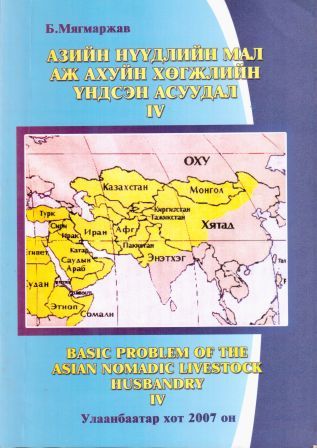Myagmarjav.B (Sc. D), Professor
“Main Problems of the Asian Nomadic Live Stock Husbandry”

УБ 2007, 35pp volume -IV
This monograph written by SC.D, Prof. B.Myagmarjav is the second part of his scientist work researched the world nomadic live stock husbandry.
Chapter one. Position of the Asian nomadic live stock husbandry in the World live stock husbandry
Chapter two. The Production and Head of cattle of the Asian nomadic Live stock husbandry
Chapter three. Interrelation Between Nomadic live Stock Husbandry and Other Economic Sectors
Chapter four. Specialization of the Asian nomadic Live Stock Husbandry and Direction of Products
Chapter five. The Products of the Asian Nomadic Live Stock Husbandry In the World Production
Chapter six. Future Condition of the Asian Nomadic Live Stock Husbandry
Chapter seven. Nomadic Live Stock Husbandry and Social & Economical Problems
In this have researched the present /1965-2000/, future condition and prognosis /2020/ of the Asian nomadic live stock husbandry on the facts’ basis of over 20 countries. Also has included in structure of this book result of comparative research on each countries, continents on the present condition. The book has 60 tables, over 20 diagrams and 20 figures.
This book concerns to research of economic problems of the pastoral live stock husbandry, as well as has dedicated to the readers interested the nomadic live stock husbandry of the Mongolia and other countries of Asia.
Conclusions:
1. The African and Arabian countries have two seasons; therefore here exists nomadism type on temperate and humidity seasons. Also subtypes divided into borderland of Africa, Sahara and Sahelia.
2. Author includes to the regions having a nomadic livestock husbandry 20 countries of Asia and 20 countries of Africa in result of comparative studies of many research works of the scholars by using distinctly systematical criterions. The differentiation on countries having the nomadic animal husbandry in Asia, Africa and in the world enables us to determine the development and present condition, perspectives on nomadic animal husbandry and settlement animal husbandry and distinction between these types of an economy.
3. There are features of labor loading and methods for livestock breeding of nomads by all nomadism types.
4. If compared with countries having settlement husbandry the population growth of the countries having a nomadic livestock husbandry is higher. And it influences development nomadic livestock husbandry.
5. 75-85% percents of herdsmen-nor-nads of Asia and Africa live in the regions having a nomadic livestock husbandry.
6. To export these products to the African countries having long tradition of the using nomadic livestock husbandry’s products.
7. To export these products to the high developed countries having needs for using the ecological pure products. The Index for food and agriculture is the most important criterion for reveals the changing process of macro condition of livestock husbandry.
8. Two basic branches of agriculture as an agrarian and livestock husbandry have a differently densities in countries. Such as, in the Mongolia, Botswana, Ethiopia and Algeria the livestock husbandry has the main position and in the Afghanistan, Chad and Syria the agrarian has a main position.
· In the regions having nomadic livestock husbandry has located the 15 percent of the world cultivated field and in the last 30 years a crop from each hectare grows on 1,6 time, also in this period in settlement livestock husbandry a crop from each had grew in 2,3 times.
· Haymaking is possessions land for pastoral livestock husbandry, in countries such as Mongolia has a widely pastoral land for using on haymaking, and after haymaking it is possible to use for herding livestock.
9. Livestock nourishment prepared from haymaking completes the nourishment basis of livestock and saves from gang/dryness/ and zud/livestock plague/